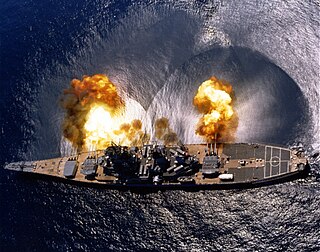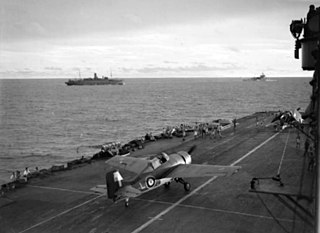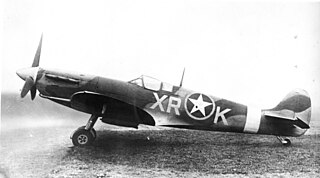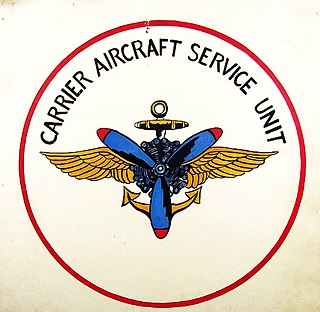
A torpedo bomber is a military aircraft designed primarily to attack ships with aerial torpedoes. Torpedo bombers came into existence just before the First World War almost as soon as aircraft were built that were capable of carrying the weight of a torpedo, and remained an important aircraft type until they were rendered obsolete by anti-ship missiles. They were an important element in many famous Second World War battles, notably the British attack at Taranto, the sinking of the German battleship Bismarck, and the Japanese attack on Pearl Harbor.

A reconnaissance aircraft is a military aircraft designed or adapted to perform aerial reconnaissance with roles including collection of imagery intelligence, signals intelligence, as well as measurement and signature intelligence. Modern technology has also enabled some aircraft and UAVs to carry out real-time surveillance in addition to general intelligence gathering.

A warship or combatant ship is a naval ship that is built and primarily intended for naval warfare. Usually they belong to the armed forces of a state. As well as being armed, warships are designed to withstand damage and are typically faster and more maneuverable than merchant ships. Unlike a merchant ship, which carries cargo, a warship typically carries only weapons, ammunition and supplies for its crew. Warships usually belong to a navy, though they have also been operated by individuals, cooperatives and corporations.

A seaplane tender is a boat or ship that supports the operation of seaplanes. Some of these vessels, known as seaplane carriers, could not only carry seaplanes but also provided all the facilities needed for their operation; these ships are regarded by some as the first aircraft carriers and appeared just before the First World War.

Naval gunfire support (NGFS), also known as naval surface fire support (NSFS), or shore bombardment, is the use of naval artillery to provide fire support for amphibious assault and other troops operating within their range. NGFS is one of several disciplines encompassed by the term naval fires. Modern naval gunfire support is one of the three main components of amphibious warfare assault operations support, along with aircraft and ship-launched land-attack missiles. Shipborne guns have been used against shore defences since medieval naval warfare.

The Vought OS2U Kingfisher is an American catapult-launched observation floatplane. It was a compact mid-wing monoplane, with a large central float and small stabilizing floats. Performance was modest because of its low-powered engine. The OS2U could also operate on fixed, wheeled, taildragger landing gear.

Chikuma (筑摩) was the second and last vessel in the Tone class of heavy cruisers in the Imperial Japanese Navy. The ship was named after the Chikuma River in Nagano Prefecture. Entering service in 1939, Chikuma saw battle during World War II in the Pacific, hunting small allied ships in the Indian Ocean and serving in many escorting missions throughout many large-scale aircraft carrier battles between Japan and the United States. On the 25 of October 1944, she served in the Battle off Samar where she possibly sank the escort carrier USS Gambier Bay and damaged the destroyer USS Heermann, before being crippled by gunfire from the destroyer escort USS Samuel B. Roberts and sunk by air attacks.

Naval aviation is the application of military air power by navies, whether from warships that embark aircraft, or land bases.

An aircraft catapult is a device used to allow aircraft to take off in a limited distance, typically from the deck of a vessel. They can also be installed on land-based runways, although this is rarely done. They are usually used on aircraft carriers as a form of assisted take off.
Tone (利根) was the lead ship in the two-vessel Tone class of heavy cruisers in the Imperial Japanese Navy. The ship was named after the Tone River, in the Kantō region of Japan and was completed on 20 November 1938 at Mitsubishi's Nagasaki shipyards. Tone was designed for long-range scouting missions and had a large seaplane capacity. She was extensively employed during World War II usually providing scouting services to their aircraft carrier task forces. She almost always operated in this capacity in conjunction with her sister ship Chikuma.

A submarine aircraft carrier is a submarine equipped with aircraft for observation or attack missions. These submarines saw their most extensive use during World War II, although their operational significance remained rather small. The most famous of them were the Japanese I-400-class submarines and the French submarine Surcouf, although small numbers of similar craft were built for other nations' navies as well.

The Curtiss SOC Seagull was an American single-engined scout observation seaplane, designed by Alexander Solla of the Curtiss-Wright Corporation for the United States Navy. The aircraft served on battleships and cruisers in a seaplane configuration, being launched by catapult and recovered from a sea landing. The wings folded back against the fuselage for storage aboard ship. When based ashore or on carriers the single float was replaced by fixed wheeled landing gear.

HMS Ark Royal was the first ship designed and built as a seaplane carrier. She was purchased by the Royal Navy in 1914 shortly after her keel had been laid and the ship was only in frames; this allowed the ship's design to be modified almost totally to accommodate seaplanes. During the First World War, Ark Royal participated in the Gallipoli Campaign in early 1915, with her aircraft conducting aerial reconnaissance and observation missions. Her aircraft later supported British troops on the Macedonian Front in 1916, before she returned to the Dardanelles to act as a depot ship for all the seaplanes operating in the area. In January 1918, several of her aircraft unsuccessfully attacked the German battlecruiser SMS Goeben when she sortied from the Dardanelles to attack Allied ships in the area. The ship left the area later in the year to support seaplanes conducting anti-submarine patrols over the southern Aegean Sea.

Nisshin (日進) was a seaplane tender (AV) of the Imperial Japanese Navy during World War II.

Aircraft carriers are warships that evolved from balloon-carrying wooden vessels into nuclear-powered vessels carrying scores of fixed- and rotary-wing aircraft. Since their introduction they have allowed naval forces to project air power great distances without having to depend on local bases for staging aircraft operations.

The Stearman XOSS was an American biplane observation floatplane developed by Stearman Aircraft for the United States Navy during the late 1930s. Intended to replace the Curtiss SOC Seagull in service aboard battleships, it proved inferior to the Vought OS2U Kingfisher in a fly-off, and did not enter production.

The Vought XSO2U was an American observation floatplane developed by Vought-Sikorsky for the United States Navy during the late 1930s. Intended to replace the Curtiss SOC Seagull in service as a scout aboard cruisers, it proved superior to the Curtiss SO3C in evaluation, but failed to win a production contract due to Vought's lack of manufacturing capacity.

Observation Squadron 7 (VOS-7) was a United States Navy artillery observer aircraft squadron based in England during Operation Overlord. The squadron was assembled expressly to provide aerial spotting for naval gunfire support during the invasion of Normandy. Personnel and aircraft were assembled on 1 June 1944 and began flying missions on 6 June 1944. The squadron was disbanded when Allied capture of the town of Cherbourg ended naval bombardment responsibilities on 26 June 1944. It is thought to be one of the shortest-lived squadrons in the history of United States military aviation.

Observation seaplanes are military aircraft with flotation devices allowing them to land on and take off from water. Their primary purpose was to observe and report enemy movements or to spot the fall of shot from naval artillery, but some were armed with machineguns or bombs. Their military usefulness extended from World War I through World War II. They were typically single-engine machines with catapult-launch capability and a crew of one, two or three. Most were designed to be carried aboard warships, but they also operated from seashore harbors.

Carrier Aircraft Service Units (CASU) were United States Navy units formed during World War II for the Pacific War to support naval aircraft operations. From 1942 to 1946, 69 Carrier Aircraft Service Units were formed to repair and maintain aircraft. The first unit was deployed to Naval Station Pearl Harbor. The CASU-11, was deployed on January 22, 1943 at Naval Air Station San Diego. During the war the Navy lacked enough aircraft carriers to complete all the operational requirements.

















